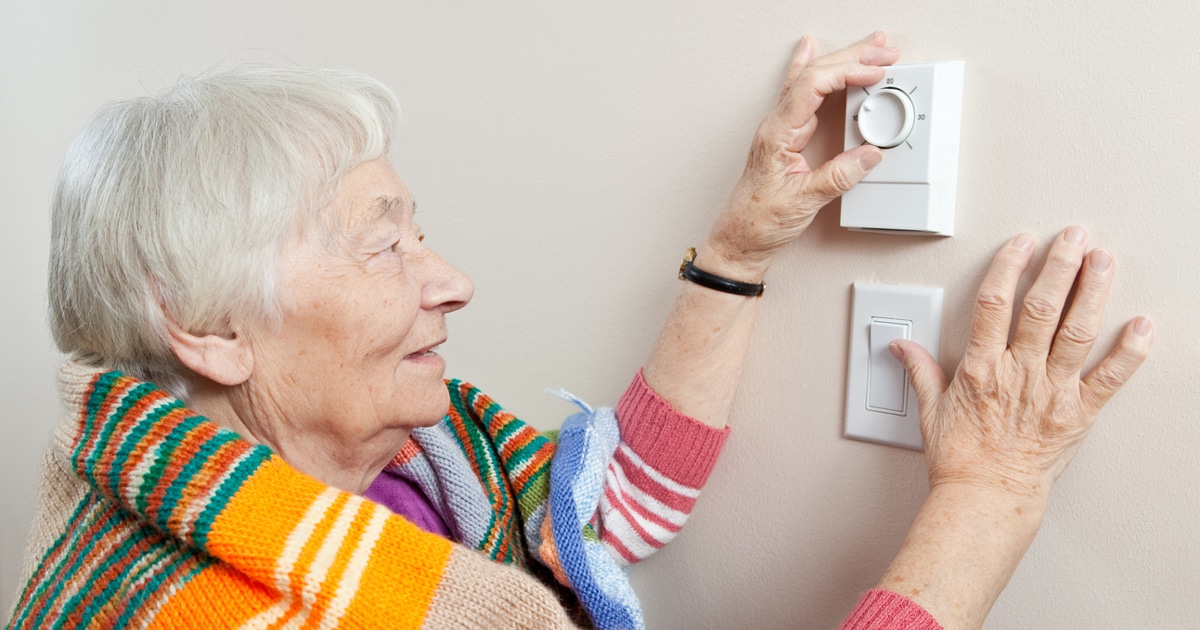Aging brings with it a lot of physical changes that are simply a normal part of life. Among them is an increased sensitivity to cold temperatures, thanks to a slower metabolism, thinner skin, and some diseases, conditions and even medications. But there are ways to stay warm even as the temperature drops — indoors and outdoors. Try these tips to stay warm this winter.
Senior Health: 7 Tips to help you stay warm this winter
#1 — Turn up the heat.
Obviously, the first step to staying warm is to turn up the heat. That’s the fastest way to warm up a home and many seniors keep their heat higher than they did when younger. To ensure that a furnace can do the job, make sure to have it checked each fall before it gets cold, follow up on maintenance, change filters regularly, and make sure the furnace and all the ducts and vents are not obstructed and that the thermostat is working properly. Find out what maintenance a gas furnace needs in the International Association of Certified Home Inspectors “Gas Furnace Inspection Checklist.”
#2 — Layer clothing.
Seniors who are beginning to feel colder than normal can easily benefit from layering clothing. This is something outdoor enthusiasts have been doing for a long time to help them stay comfortable in all kinds of weather. According to the REI Co-op blog, “Layering Basics,” the best way is to have a base layer like long underwear, a middle layer to hold on to body heat, and a third layer to provide a shield from the elements. For seniors indoors, that last layer could be a sweater, wool shirt, or other jacket-like clothing to keep the chill off. Also be sure to wear a hat, gloves and warm boots when outdoors.
#3 — Let the sunshine in.
Winter can be bright when the sun is out and reflects off the snow, so when blessed with a sunny day, open drapes and shades and take advantage of the warmth and the light. Not only will the sun warm and brighten the home, but seniors can also benefit from just sitting in the sunshine because it helps them create vitamin D and shake off the “winter blues,” now known as seasonal affective disorder or SAD, which can cause depression.
#4 — Drink warm beverages.
Sipping a cup of coffee or tea is a great way to warm up from the inside out, but there are many more great warm drinks to savor including hot chocolate, latte, apple cider, milk with cinnamon, and cranberry juice. And for each, there are dozens of ways to make them fancy and fabulous as shown in thetopinspeired.com blog, “Top 10 Non-Alcoholic Hot Drinks for Fall and Winter.” By avoiding alcohol, seniors will also warm up quicker because alcohol makes you feel colder, not warmer, as many believe.
#5 — Run a humidifier.
Humid air feels warmer (which is why muggy summer days seem so hot) so running a humidifier can help. But humidifiers have other benefits as well, including minimizing itchy dry skin, allergies, sinus problems, irritated eyes, and possibly preventing spread of the flu through the air. To learn more and choose the best type of humidifier for a senior’s home, check out the medicalnewstoday.com article, “Benefits of Using a Humidifier.”
#6 — Cover-up.
When seated for long periods cover up with a throw or blanket. One of the warmest choices is down and the options are available to match just about any preference or décor. Down is also very light which may be preferable for seniors who are frail or injured. Another excellent choice for many seniors is an electric warming throw, which is just like an electric blanket but smaller. These are also available in plush faux fur that is especially soft on seniors’ thinner, more fragile skin. Be aware that seniors with memory problems or certain conditions like diabetes, paralysis, or Parkinson’s disease maybe not be good candidates for using electric throws or blankets. If you’re unsure, check with their physician.
#7 — Move.
Physical activity is one of the best ways to warm up and there are plenty of ways seniors can get moving. Housework is one great way as is exercising via online sources like AARP or YouTube. Even chair exercises can help generate heat while keeping joints and muscles agile.
At Ganton’s Countryside we offer residents a warm and active environment with plenty of fun and invigorating things to do, indoors and out. For more information about Countryside, please call Margaret Nagel at (517) 206-5000 or download our brochure to learn about our care levels, cost, and amenities.


